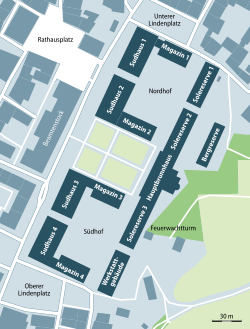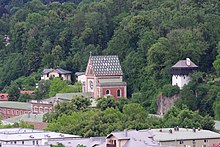Ensemble Alte Saline
The ensemble Alte Saline is a building complex in Bad Reichenhall and is in accordance with Article 1, paragraph 3 of the Bavarian Monument Protection Act under monument protection . In addition to the old saltworks with the main fountain, connected buildings and the inner courtyards, the ensemble also includes the saltworks street, the official staff , the fire watch tower and the upper and lower Lindenplatz.
The Obere Stadt ensemble is seamlessly connected to the Alte Saline ensemble in the south , and the Rathausplatz ensemble in the northwest .
description
The core of the Alte Saline ensemble is the old saltworks in Bad Reichenhall. This includes the main well, brine reserves, brewhouses, magazines, the workshop building, the mountain reserve, the Brunnhaus chapel, the underground springs, the three inner courtyards, the two wells in the northern and southern inner courtyards and the enclosure . Also part of the ensemble is the official staff on the opposite side of Salinenstrasse, which for a long time was the administration building for the saline facilities. Since the generous spacing areas were planned for the construction of the facility with regard to fire protection, Oberer and Unterer Lindenplatz as well as Salinenstraße are also part of the ensemble. The fire watchtower above the saltworks was built before the town fire in 1834 at the beginning of the 19th century, but is also part of the ensemble due to its close historical connection with the old saltworks.
history
The ensemble Alte Saline is located at the foot of Gruttensteins where already in originally and prehistoric salt from the time salt springs was recovered. The history of salt production in Bad Reichenhall in the Middle Ages was subject to constant change, which was of technical, political or natural origin. The last major, incisive incident was the great fire of Reichenhall in 1834 , in which ¾ of the city and in particular all of the salt works were destroyed. According to King Ludwig I's will , the new building should meet high technical and representative requirements. Friedrich von Gärtner designed the official staff , which was built from the spring of 1836. The foundation stone for the technical facilities was laid in 1838. In charge of this were Friedrich von Schenk, the director of the city’s saltworks management at the time, and Joseph Daniel Ohlmüller , who mainly designed the Brunnhaus chapel. The first brewhouse on Unteren Lindenplatz started operations in 1844, and the last of the four brewhouses was not completed until 1851. The fountains in the two outer courtyards were not built until 1859. After the New Saline was built outside the city, salt production in the Old Saline ended in 1929. Since then, the buildings have served different purposes.
Today the salt museum is housed in the main well, and daily tours are offered through the technical facilities and the underground spring construction. There are retailers and physiotherapists in the brewhouses along Salinenstrasse, while the magazines house a pharmacy, several doctors, restaurants and rooms for cultural events. Solereserve 1 houses a medical center, Solereserve 3 the Reichenhall Academy . The seat of the owner, a local developer, is located in the workshop building.
Individual monuments
Old salt works
The monument Old Salt, which is registered in the list of monuments under number D-1-72-114-127 superior products such as main Brunnhaus, brine reserves, brew houses, magazines, the Brunnhaus chapel and the fountain in the two outer courtyards, the enclosure of the site.
All buildings are geometrically grouped in brick with frames and cornices in Nagelfluh. Brewhouses, brine reserves and magazines are designed as sober functional buildings, the main well in the center of the facility is intended to combine constructive thinking, considerations of expediency and Romanesque building spirit. This is particularly evident on the facade with the narrow, raised and gable-topped portal structure. The Brunnhaus Chapel with its steep roof rises above the main portal above the other buildings. The wells are octagonal, each with a cast iron figure on the central pillars.
Official staff
The official staff "der Alten Saline" is registered under the number D-1-72-114-126 in the list of monuments. It was the first building to be erected and completed after the great city fire of 1834 . The design comes from Friedrich von Gärtner , who is based heavily on the Bavarian State Library in Munich, which was also designed by Gärtner . With its plastered facade, the civil servants' stick forms a strong antithesis to the exposed brick walls of the salt works.
The official staff is an elongated, three-storey building wing with 25 axes. Gärtner combined his treasure trove of forms from the Middle Ages and the early Renaissance with a round arch style.
Fire watchtower
The fire watchtower is not one of the saline buildings and was built some time before it. Fire protection was a very high priority in the new construction of the saline, which is why the fire watchtower was included in the ensemble in its capacity and due to the close historical connection. It is recorded in the list of monuments under the number D-1-72-114-142. The fire watchtower is located a good bit above the salt works on a rock in front of the Gruttenstein and can only be reached from above - via the Pfannhauserweg , on which the Gruttenstein Castle is also located.
War memorial
The war memorial on Untere Lindenplatz, which was designed by Franz Bürgerling in 1923 as a souvenir for those who fell in World War I , is actually not part of the Alte Saline ensemble. But due to the placement on Untere Lindenplatz, which is part of the ensemble, the war memorial is also in this area. It depicts a lion on a brick base, which is located between two red marble fountain basins. The monument is entered in the list of monuments under the number D-1-72-114-169.
See also
literature
- List of monuments of the Bavarian State Office for Monument Preservation
- Johannes Lang : History of Bad Reichenhall. Ph.CW Schmidt, Neustadt / Aisch 2009, ISBN 978-3-87707-759-7 .
- Herbert Pfisterer: Bad Reichenhall in its Bavarian history Motor + Touristik-Verlag, Munich, 1988
- Fritz Hofmann : The Terrible Years of Bad Reichenhall , wdv-Verlag, Mitterfelden and Bavarian Salt Library , City of Bad Reichenhall 1995
Web links
- Bavarian Monument Atlas (cartographic representation of the Bavarian architectural and ground monuments by the BLfD , requires JavaScript)
Coordinates: 47 ° 43 ′ 15.7 " N , 12 ° 52 ′ 38.2" E





